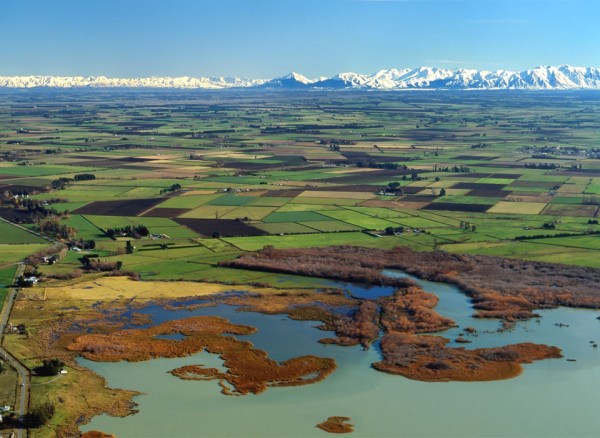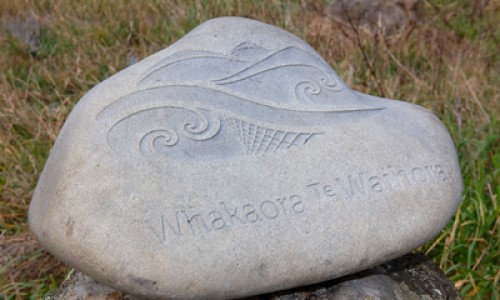Te Waihora/Lake Ellesmere is a living hāpua/shallow, brackish coastal lake-lagoon that is nationally and internationally significant for its cultural, ecological and economic values.
 The catchment, which drains 276,000 hectares, extends from the foothills of the Kā Tiritiri o te Moana/Southern Alps to the Rakaia River, the Waimakariri River, the hills of Banks Peninsula and the plains in between.
The catchment, which drains 276,000 hectares, extends from the foothills of the Kā Tiritiri o te Moana/Southern Alps to the Rakaia River, the Waimakariri River, the hills of Banks Peninsula and the plains in between.
It is salty and shallow, with an average depth of 1.4 metres and a maximum depth of around 2.7 metres. It is a brackish coastal lagoon that is termed eutrophic, which means it is rich in plant nutrients.
Internationally, it’s important for its biodiversity and indigenous fish species. Te Waihora is teeming with life and highly productive, but it isn’t as healthy as it should be. There is much work to do.
Explore the scientific data for this lake
- Environment Canterbury monitors water quality at 5 sites around the lake, and one recreational water quality site. Visit Land Air Water Aotearoa's website (LAWA) for the latest water quality data
- Te Waihora covers a total catchment area of 276,000 hectares and is in one of Environment Canterbury's water management zones, Selwyn Waihora. The Selwyn River/Waikirikiri is the main inflowing river, which is itself fed by key tributaries such as the Hororata, Hawkins and Waianiwaniwa rivers
- View the water quality of key tributaries of Te Waihora/Ellesmere catchments by visiting the LAWA website
- In recent years, Waihora Ellesmere Trust has coordinated an annual multi-agency bird count around Te Waihora.
Lake health
It is widely acknowledged that the ecological health of both the lake and the surrounding tributaries has declined. Since the second half of the 19th century, the lake catchment has been predominantly agricultural. This has led to increasing inflows of nutrients and sediment.
State of the Lake Reports
The following State of the Lake reports have been published by Waihora Ellesmere Trust, with contributions from many agencies and experts.
- 2017 State of the Lake Report
- 2015 State of the Lake Report
- 2013 State of the Lake Report
- Visit the Waihora Ellesmere Trust website to find the 2008 State of the Lake and Future Management Reports
Key turning points for the health of Te Waihora
Key turning points for the health of Te Waihora included the large-scale clearances of bush and draining of wetlands in the 19th century to allow for farming. In the 1960s, the beds of naturally occurring macrophytes (floating or submerged plants) disappeared from the lake.
This happened for a range of reasons including the impact of the Wahine Storm in 1968. This was another turning point for the quality of the lake’s water.
The macrophytes buffer waves, take up nutrients and improve water quality. After their disappearance, the health of the lake and its tributaries declined significantly. Intensification of agriculture including the increase of dairying in this catchment since the 1990s has further increased pressure on the environment.
Climate change and urban development have also contributed to the decline of water quality.

A shared vision
To restore and rejuvenate the mana, mauri and ecosystem health of Te Waihora and its catchment – a comprehensive programme of work is needed. Whakaora Te Waihora was the first joint land management plan between iwi and the Crown in Aotearoa New Zealand. It is an operational programme of the Te Waihora Co-Governance Group.
The programme is a shared commitment to the restoration and rejuvenation of the mauri and ecosystem health of Te Waihora/Lake Ellesmere.
The Joint Cultural and Ecological Restoration Plan was approved by the Te Waihora Co-Governance in 2011 with the aims of:
- Accelerating the restoration of ecosystem health of a significant wetland, notable for its outstanding wildlife and native vegetation values
- Restoring and enhancing specific cultural sites and mahinga kai
- Protecting and restoring the lake margin wetland habitats, existing indigenous vegetation and wildlife and restoration of specific lowland tributary streams and riparian habitats
- Improving lake and catchment management practices by focusing on sustainable land use and drainage practices within the catchment
- Establishing a robust monitoring and investigations programme that ensures the lake response to management is understood and management activities are adapted accordingly.
All outcomes of Whakaora Te Waihora will be achieved within the context of Ki Uta Ki Tai (Mountains to the Sea)
Progress
The Whakaora Te Waihora programme delivers projects that will drive change to achieve the restoration plan. Some of the projects include:
- Planting over 350,000 plants.
- Re-establishing two wetlands - Te Repo Orariki and Whakaora Te Ahuriri.
- Working towards the restoration of Te Waikēkēwai/Waikēkēwai Stream through a co-managed project led by Te Taumutu Rūnanga.
- Supporting the Weed Strikeforce, which is working towards eliminating weeds and willows from the lakeshore, and is delivered by the Department of Conservation.
- Establishing real-time monitoring of lake water quality.
- Rebattering 21.3 kilometres of waterways to reduce sediment.
- Completing scientific investigations, including for fisheries management, lake opening, mahinga kai bio-health, nutrient processes and more.
- Supporting Te Ara Kākāriki’s and Enviroschools’ ‘Kids Discovery Plant-out’ programme to reach over 1000 students.
